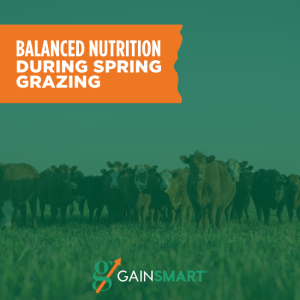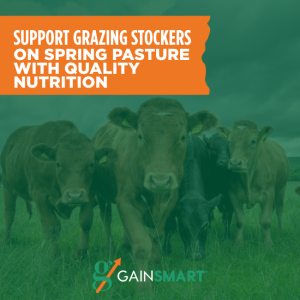
The United States is an ideal location for stocker cattle operations, thanks to its diverse and abundant forage resources. From the cool-season grasses of the Midwest to the warm-season varieties in the South, the country’s vast grazing lands provide year-round nutrition for growing cattle. This versatility in forage options allows producers to raise stocker cattle efficiently, optimizing growth rates and profitability while maintaining sustainable grazing systems.
Tall fescue, scientifically known as Festuca arundinacea, is a cool-season perennial grass widely cultivated in the U.S. for forage and hay production. Due to its adaptability, drought resistance and high yield, tall fescue hay is a valuable feed resource for cattle when harvested and dried. However, its nutritional value and potential health effects depend on various factors, including harvesting techniques, maturity at cutting and whether it contains toxic endophytes.
Your Partners in Raising Cattle
Curious about who you’re getting advice from? Gain Smart® is a renowned brand of mineral supplements designed to enhance cattle health, optimize growth and improve feed efficiency. Our products support commercial producers looking to maximize their operations. Best of all, Gain Smart products ensure balanced nutrition for livestock.
The Gain Smart brand is developed by BioZyme® Inc., a leading fermentation company pioneering advancements in animal nutrition and health. Through innovative research and high-quality manufacturing, BioZyme creates powerful solutions that improve animal performance and support producer profitability in the agricultural industry.
Our mission: undeniable positive impact on the health and wellness of your animals and your business.
We created this article to detail the use of tall fescue hay in stocker cattle, its benefits, potential challenges and best management practices to optimize its nutritional value.
Characteristics of Tall Fescue Hay
Tall fescue is famously durable and can thrive under adverse conditions, including poor soil fertility, drought and heavy grazing pressure. Tall fescue hay has several characteristics that make it a popular choice for livestock feed. Those key characteristics include:
Nutritional Content
Tall fescue hay typically contains 8-14% crude protein and 50-60% total digestible nutrients (TDN), depending on the maturity at harvest and fertilization practices. It is a good source of several minerals, including calcium, phosphorus and potassium.
Tall fescue hay has a moderate to high fiber content, which can impact digestibility, especially if harvested too late. It contains moderate energy content, typically lower than alfalfa but sufficient for maintenance and moderate performance needs.
Growth & Hardiness
Tall fescue’s deep root system allows it to withstand dry conditions better than many other forage grasses. In addition to being drought-resistant, it withstands colder temperatures better than some other grasses. Endophyte-infected varieties have natural pest resistance but can pose toxicity risks. Finally, it is highly persistent with proper management and can remain productive for many years.
Palatability & Digestibility
Tall fescue hay is less palatable than forages like alfalfa or orchard grass, especially when over-mature. However, it is easy for cattle to digest if it is harvested at the boot stage – before seeds form. Cutting the tall fescue at the boot stage increases its softness and nutritional value. Delaying harvest of the tall fescue hay increases its coarseness and lowers its digestibility.
Uses of Tall Fescue Hay for Cattle
Tall fescue hay is primarily used for feeding cattle in several regions where it is a dominant forage species, including the South, Southeast, Midwest and Pacific Northwest. Below are its primary uses in cattle production:
Winter Feed for Beef Cattle
Tall fescue hay is commonly used as a winter feed source for beef cattle when pasture availability is limited. It provides a consistent source of fiber and energy, helping cattle maintain body condition during cold months.
- Storage and Feeding: Properly stored hay retains its nutritional value and prevents spoilage, ensuring a reliable feed source.
- Supplementation Needs: Since mature tall fescue hay can be low in digestible energy and protein, supplementation with protein sources like soybean meal, or energy sources like corn, may be necessary.
Hay for Growing & Finishing Cattle
For growing and finishing cattle, tall fescue hay can be included in diets to provide necessary fiber while maintaining proper rumen function. However, due to its moderate digestibility, it is often supplemented with high-energy feedstuffs to promote efficient growth.
- Backgrounding Programs: Many beef producers use tall fescue hay as a primary forage in backgrounding programs, where calves are fed moderate-energy diets to prepare them for finishing.
- Finishing Cattle: In finishing diets, tall fescue hay is used in limited amounts to ensure sufficient fiber intake without reducing overall feed efficiency.
Grazing & Hay Feeding Combinations
Some producers utilize a combination of tall fescue grazing and hay feeding to optimize forage utilization throughout the year. This approach allows flexibility in managing forage availability and maintaining cattle nutrition.
- Stockpiling for Winter Grazing: Tall fescue is commonly stockpiled in late summer and early fall for winter grazing. Cattle may graze stockpiled fescue while also receiving hay supplementation as needed.
- Bale Grazing: In this system, round bales of tall fescue hay are strategically placed in pastures to provide cattle with access to hay while minimizing waste and reducing labor.
Challenges Associated with Tall Fescue Hay
Despite its benefits, tall fescue hay presents some challenges, primarily due to the presence of endophytes—fungi that produce toxic alkaloids. Let’s explore the 2 major challenges of feeding tall fescue hay:
1. Endophyte Toxicity (Fescue Toxicosis)
One of the most significant concerns with tall fescue hay is fescue toxicosis, caused by the presence of Neotyphodium coenophialum, an endophytic fungus. The alkaloids produced by this fungus can negatively impact cattle health and performance, leading to:
- Reduced Weight Gains: Cattle consuming endophyte-infected fescue often have lower average daily gains. This can be a concern, especially when grazing stocker calves.
- Reproductive Issues: Pregnant cows may experience reduced fertility rates, prolonged gestation and aborted fetuses due to toxicity.
- Heat Stress: Affected cattle struggle to regulate body temperature, leading to increased susceptibility to heat stress.
2. Variable Nutritional Quality
The nutritional quality of tall fescue hay can vary widely depending on management practices:
- Harvest Timing: Late-cut hay is often coarse, high in fiber, and low in digestibility. Be sure to cut the fescue hay at the boot stage or earlier to maximize the nutritional value.
- Fertilization: Poor fertility management can lead to lower protein and energy content.
- Storage Conditions: Improper storage can result in mold growth and nutrient losses.
Best Management Practices for Feeding Tall Fescue Hay to Cattle
To maximize the benefits of tall fescue hay while minimizing its drawbacks, producers should follow best management practices:
Use Endophyte-Free or Novel-Endophyte Varieties
When possible, select endophyte-free or novel-endophyte tall fescue varieties to help reduce the risk of fescue toxicosis. Novel-endophyte varieties retain the persistence benefits of infected fescue while reducing toxic alkaloid levels.
- Endophyte-Free Varieties: These are safer for livestock but may lack the same resilience.
- Novel Endophyte Varieties: Bred for improved persistence without the harmful effects of toxic endophytes.
Harvest at the Right Maturity
To improve digestibility and nutrient content:
- Harvest tall fescue in the early boot stage for higher protein and energy levels.
- Avoid cutting hay too late when fiber levels become excessively high and digestibility decreases.
Test Hay for Nutritional Quality
At BioZyme, we believe in hay testing. In fact, we think it is so important to your operation, we offer it for free to our customers. Once your hay is tested, you will know its nutritional value and know best how to supplement it. Regular forage testing helps determine:
- CP Content: Ensures sufficient protein for growth and maintenance.
- TDN: Helps assess energy availability.
- Endophyte Levels: Identifies potential toxicity risks.
Provide Nutritional Supplements
If tall fescue hay is low in protein or energy, supplementation is necessary:
- Protein Supplements: Soybean meal, distillers grains or cottonseed meal.
- Energy Sources: Corn, barley, or high-quality silage.
- Minerals and Vitamins: Balanced mineral supplementation, particularly magnesium, can help mitigate fescue toxicosis effects.
- A complete supplement from Gain Smart or VitaFerm®!
Monitor Cattle for Signs of Toxicosis
Producers should closely observe cattle for signs of fescue toxicosis and adjust feeding strategies accordingly. Strategies such as rotational grazing, dilution with other forages and shade provision can mitigate heat stress effects.
Gain Smart Can Help
Allowing your stockers to graze tall fescue or providing them tall fescue hay is a good way to provide forage. Regardless of the forage type, we encourage providing access to vitamin and mineral supplements to maintain overall health and support optimal growth. Ensure that cattle have access to a balanced mineral mix containing essential nutrients such as calcium, phosphorus, magnesium and trace minerals.
Gain Smart is a line of vitamin and mineral supplements for stocker cattle that promotes healthy, economical pounds. Gain Smart offers 4 different free-choice vitamin and mineral supplement formulas to fit any feeding scenario. All formulas consist of the following:
- AO-Biotics® Amaferm®, a prebiotic research-proven to enhance digestibility.
- Include organic copper, iodine and zinc for maximum bioavailability and hoof health.
- Provide nutritional support for a healthy immune system.
The 4 Gain Smart formulas for stocker cattle include:
- First, Gain Smart Stocker, which maximizes efficient gain.
- Second, Gain Smart Stocker Wheat, which maximizes efficient gain on wheat or small grain pasture.
- Next, Gain Smart Stocker HEAT®, which maximizes efficient gain when temperatures are above 70 degrees Fahrenheit. Contains HEAT technology, a combination of essential oils and garlic, to support animals when heat and insects are a challenge.
- Finally, Gain Smart Stocker Balancer RU1600 maximizes efficient gain and balances high-grain diets when mixing TMR rations. It includes rumensin for improved feed efficiency.
The Gain Smart mineral is part of a 3-step program to help producers and backgrounders increase gains and keep calves healthy. Include the VitaFerm® Cattle Drench and VitaFerm® Stress Tubs as the first 2 steps of the program on fresh-weaned or just-received calves to maximize your results. Supplementing cattle on pasture with Gain Smart mineral is a great way to gain healthy, efficient pounds.
The Final Word
Tall fescue hay is a valuable forage resource for cattle, offering a reliable feed source during winter and periods of forage scarcity. While it provides moderate protein and energy levels, its effectiveness depends on proper harvesting, storage and supplementation. Producers should be aware of the potential risks of endophyte toxicity and take proactive measures to minimize its impact.
The Amaferm in the Gain Smart supplements helps your calves absorb and digest the nutrients in the tall fescue hay. Furthermore, it contains balanced vitamins and minerals to help your calf perform. The Gain Smart HEAT formula contains technology to help mitigate heat stress, one of the challenges of fescue toxicity.
Finally, research proves that cattle fed Gain Smart powered by Amaferm gain .25 pounds more per day. That’s something to get excited about!
Get your Cattle Gaining the Smart Way Today!
Have we convinced you that Gain Smart powered by Amaferm is the best way to supplement cattle? We hope so! Now that you know about Gain Smart, you can get your calves gaining today.
Gain Smart is available at any of our local authorized BioZyme Dealers. Locate the dealer nearest you.
Would you like to receive more information about keeping your cattle gaining healthy, efficient pounds? Sign up for our newsletter.

